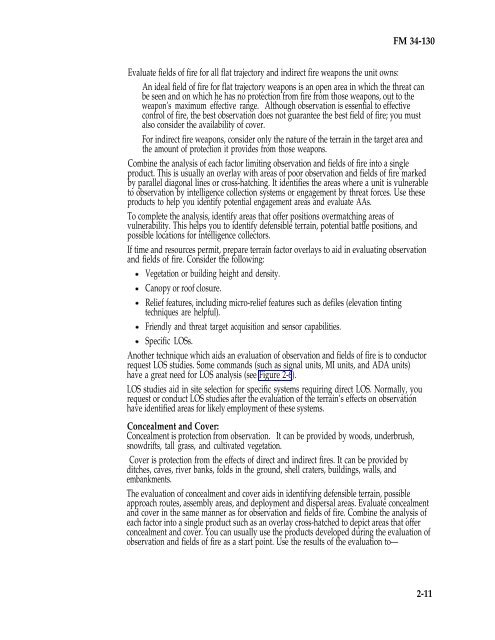Intelligence Preparation of the Battlefield - Federation of American ...
Intelligence Preparation of the Battlefield - Federation of American ...
Intelligence Preparation of the Battlefield - Federation of American ...
Create successful ePaper yourself
Turn your PDF publications into a flip-book with our unique Google optimized e-Paper software.
FM 34-130<br />
Evaluate fields <strong>of</strong> fire for all flat trajectory and indirect fire weapons <strong>the</strong> unit owns:<br />
An ideal field <strong>of</strong> fire for flat trajectory weapons is an open area in which <strong>the</strong> threat can<br />
be seen and on which he has no protection from fire from those weapons, out to <strong>the</strong><br />
weapon’s maximum effective range. Although observation is essential to effective<br />
control <strong>of</strong> fire, <strong>the</strong> best observation does not guarantee <strong>the</strong> best field <strong>of</strong> fire; you must<br />
also consider <strong>the</strong> availability <strong>of</strong> cover.<br />
For indirect fire weapons, consider only <strong>the</strong> nature <strong>of</strong> <strong>the</strong> terrain in <strong>the</strong> target area and<br />
<strong>the</strong> amount <strong>of</strong> protection it provides from those weapons.<br />
Combine <strong>the</strong> analysis <strong>of</strong> each factor limiting observation and fields <strong>of</strong> fire into a single<br />
product. This is usually an overlay with areas <strong>of</strong> poor observation and fields <strong>of</strong> fire marked<br />
by parallel diagonal lines or cross-hatching. It identifies <strong>the</strong> areas where a unit is vulnerable<br />
to observation by intelligence collection systems or engagement by threat forces. Use <strong>the</strong>se<br />
products to help you identify potential engagement areas and evaluate AAs.<br />
To complete <strong>the</strong> analysis, identify areas that <strong>of</strong>fer positions overmatching areas <strong>of</strong><br />
vulnerability. This helps you to identify defensible terrain, potential battle positions, and<br />
possible locations for intelligence collectors.<br />
If time and resources permit, prepare terrain factor overlays to aid in evaluating observation<br />
and fields <strong>of</strong> fire. Consider <strong>the</strong> following:<br />
Vegetation or building height and density.<br />
Canopy or ro<strong>of</strong> closure.<br />
Relief features, including micro-relief features such as defiles (elevation tinting<br />
techniques are helpful).<br />
Friendly and threat target acquisition and sensor capabilities.<br />
Specific LOSs.<br />
Ano<strong>the</strong>r technique which aids an evaluation <strong>of</strong> observation and fields <strong>of</strong> fire is to conductor<br />
request LOS studies. Some commands (such as signal units, MI units, and ADA units)<br />
have a great need for LOS analysis (see Figure 2-6).<br />
LOS studies aid in site selection for specific systems requiring direct LOS. Normally, you<br />
request or conduct LOS studies after <strong>the</strong> evaluation <strong>of</strong> <strong>the</strong> terrain’s effects on observation<br />
have identified areas for likely employment <strong>of</strong> <strong>the</strong>se systems.<br />
Concealment and Cover:<br />
Concealment is protection from observation. It can be provided by woods, underbrush,<br />
snowdrifts, tall grass, and cultivated vegetation.<br />
Cover is protection from <strong>the</strong> effects <strong>of</strong> direct and indirect fires. It can be provided by<br />
ditches, caves, river banks, folds in <strong>the</strong> ground, shell craters, buildings, walls, and<br />
embankments.<br />
The evaluation <strong>of</strong> concealment and cover aids in identifying defensible terrain, possible<br />
approach routes, assembly areas, and deployment and dispersal areas. Evaluate concealment<br />
and cover in <strong>the</strong> same manner as for observation and fields <strong>of</strong> fire. Combine <strong>the</strong> analysis <strong>of</strong><br />
each factor into a single product such as an overlay cross-hatched to depict areas that <strong>of</strong>fer<br />
concealment and cover. You can usually use <strong>the</strong> products developed during <strong>the</strong> evaluation <strong>of</strong><br />
observation and fields <strong>of</strong> fire as a start point. Use <strong>the</strong> results <strong>of</strong> <strong>the</strong> evaluation to—<br />
2-11
















